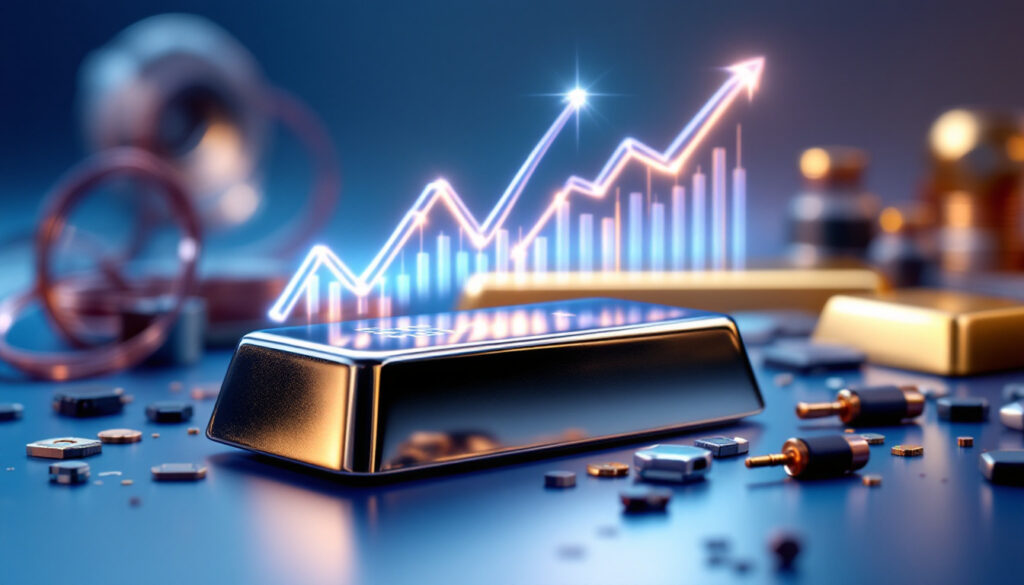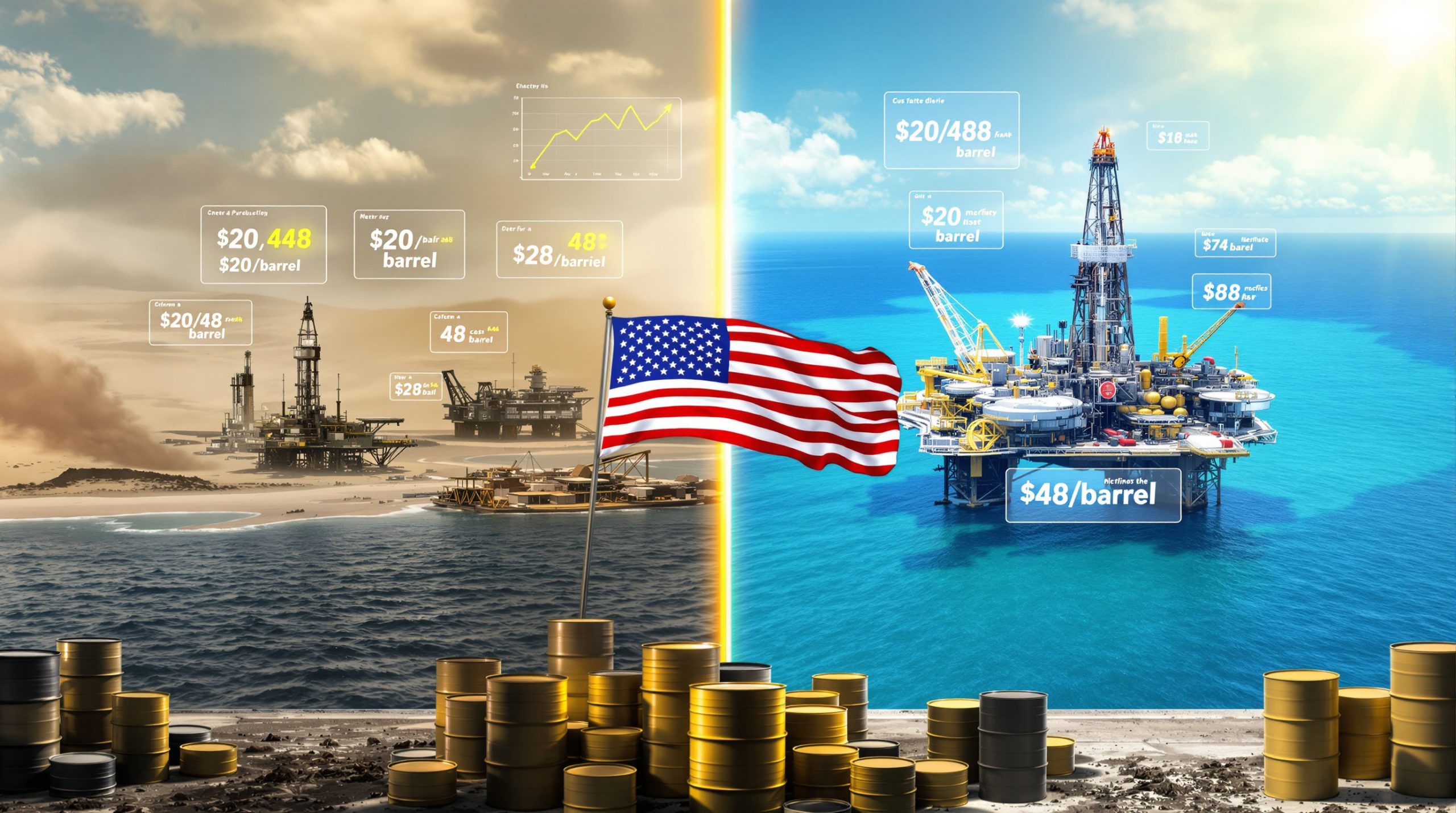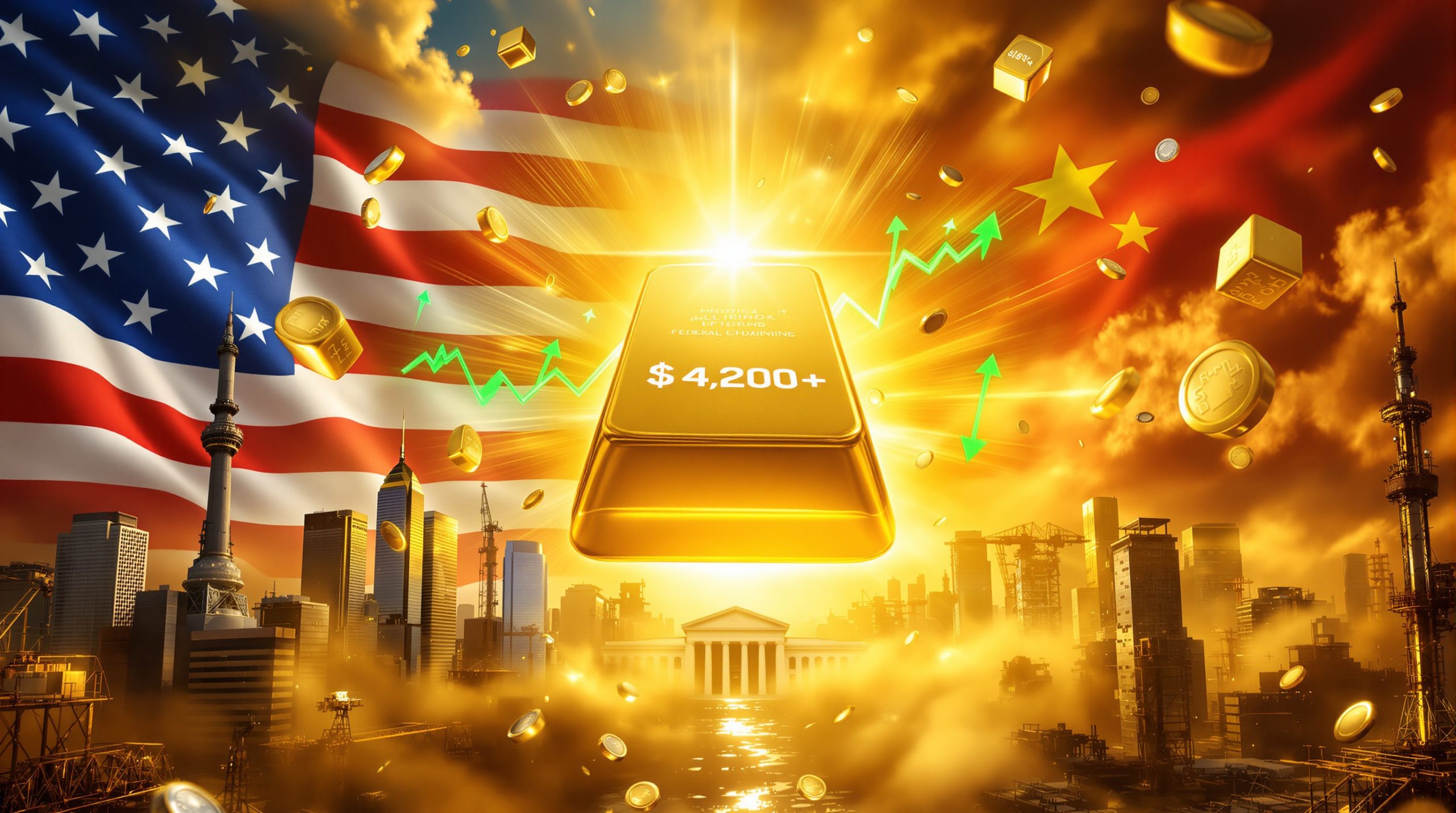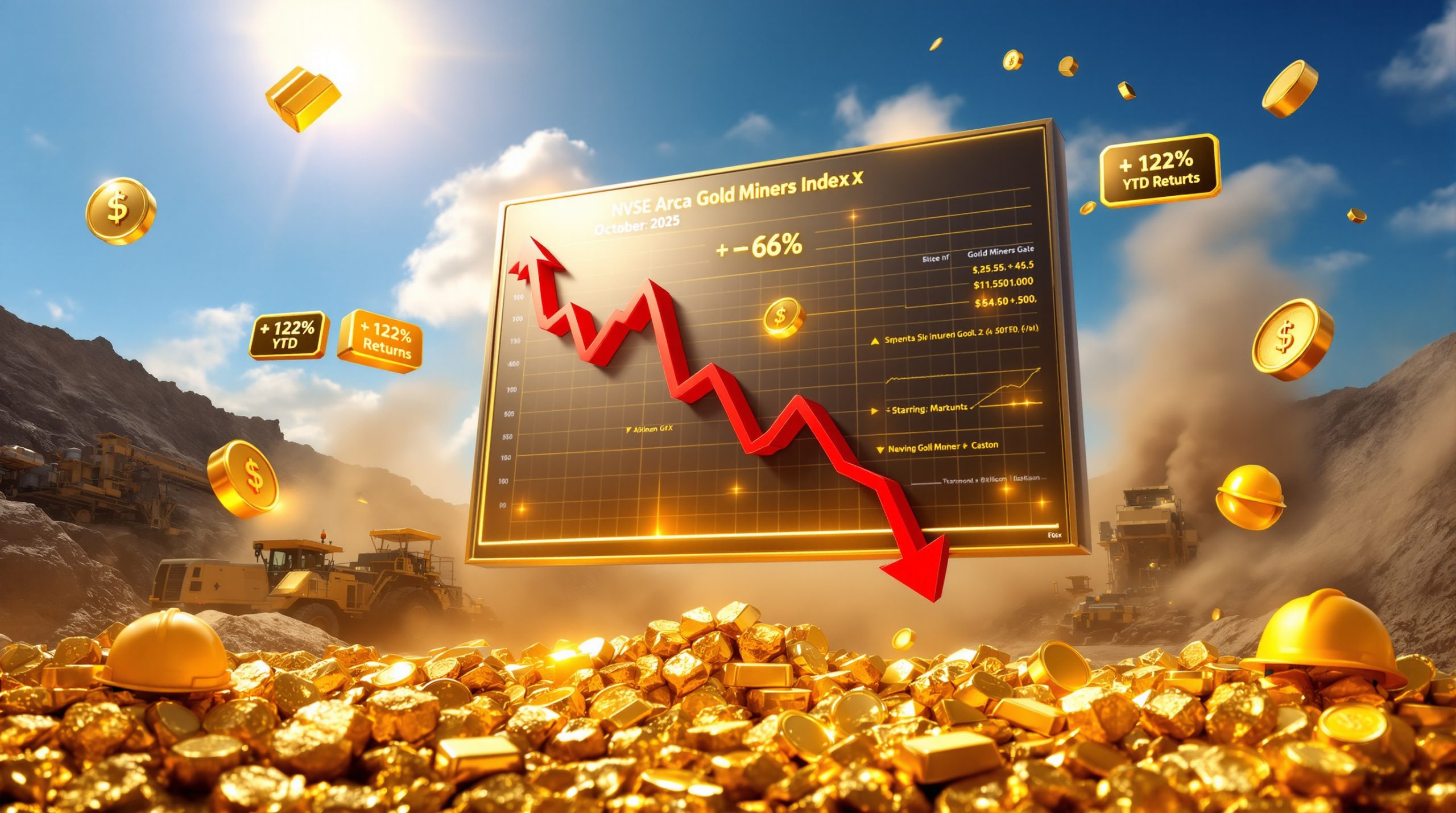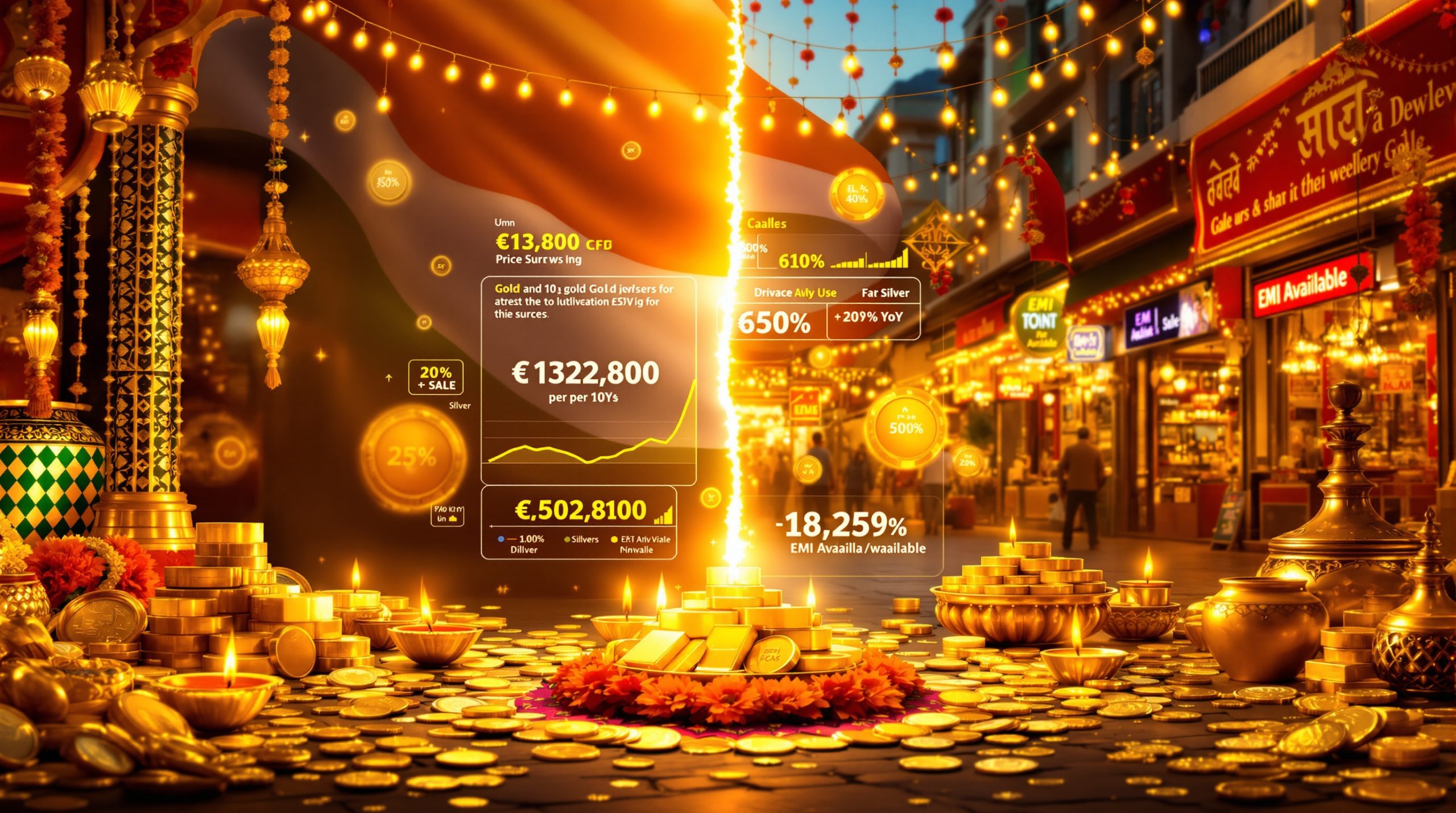What Factors Are Driving Silver Price Predictions for 2025?
The Dual Nature of Silver Finally Aligning
Silver's unique position as both a precious and industrial metal creates a rare market scenario where dual demand drivers align simultaneously. This distinctive characteristic has historically caused silver to mirror gold's movements with amplified intensity, creating significant profit potential during precious metals bull markets.
Currently, the gold-to-silver ratio stands at approximately 100:1, dramatically higher than the historical average of 60:1-70:1 maintained over centuries. This extreme deviation suggests silver is substantially undervalued relative to gold, creating what analysts describe as an "asymmetric risk-reward opportunity."
Market expert Bob Habercorn notes that even a partial reversion to an 80:1 ratio could propel silver to $43.75 if gold reaches $3,500—a modest correction that would still remain above historical norms. This mathematical relationship explains why silver specialists are increasingly confident about silver price prediction targets that may seem ambitious at first glance.
"Silver's undervaluation relative to gold creates an asymmetric risk-reward opportunity that we rarely see in mature markets. The current 100:1 ratio is simply unsustainable based on centuries of market data." – Bob Habercorn
The technical explanation for silver's dramatic moves lies in its market structure—silver's market capitalization is significantly smaller than gold's, causing its volatility to typically exceed gold's by 2-3x during decisive market trends. This volatility works powerfully in investors' favor during bull markets.
Gold's Record-Breaking Rally as a Catalyst
Gold's remarkable surge toward $3,500 per ounce provides essential momentum for silver prices. Historical precedent shows silver benefits disproportionately when gold market trends rise substantially, with particularly dramatic examples during previous bull runs.
During the 2008-2011 precious metals bull market, silver outperformed gold by an astonishing 400%, demonstrating the leverage effect that could emerge in the current cycle. This pattern reveals silver's tendency to lag initially but eventually deliver superior percentage returns:
| Period | Gold Performance | Silver Performance | Silver Leverage Factor |
|---|---|---|---|
| 2008-2011 | +166% | +448% | 2.7x |
| 2000-2011 | +600% | +913% | 1.5x |
| 1976-1980 | +721% | +1,064% | 1.5x |
The correlation coefficient between gold and silver prices since 2000 stands at 0.89, confirming the strong statistical relationship between the metals while still allowing for silver's periods of outperformance.
Technical analysts note that silver tends to gain momentum approximately 6-8 months after gold establishes a clear uptrend. With gold breaking all-time highs in 2024, this timeline aligns perfectly with projections for silver reaching $40 by mid-2025.
What Are Expert Forecasts for Silver Prices in 2025?
Near-Term Price Targets from Market Analysts
Professional forecasts for silver converge around $40 per ounce by summer 2025, representing a 40% gain from current levels. More ambitious projections suggest $50 by September 2025 if industrial demand accelerates alongside investment flows.
These targets align with silver's established volatility profile. During breakout phases, silver commonly delivers $2-3 daily price moves, allowing for rapid appreciation once key resistance levels give way. This pattern creates opportunity for both momentum traders and long-term position holders.
Expert analysis suggests several catalysts that could trigger these larger daily moves:
- Federal Reserve policy pivots
- Major industrial supply agreements
- Significant ETF inventory accumulation
- Breakdown of key technical resistance levels
Bob Habercorn emphasizes that "silver could deliver $3 daily gains once technical resistance breaks," highlighting the potential for rapid repricing once market sentiment shifts decisively.
The current Relative Strength Index (RSI) reading of 68 indicates building bullish momentum without yet reaching overbought territory, suggesting further upside potential before technical exhaustion occurs.
Technical Analysis Supporting the Bullish Case
Silver's weekly chart displays a symmetrical triangle breakout above the critical $28 per ounce threshold, established in April 2025. Technical analysis methodology suggests a measured move target of approximately $42, calculated by projecting the height of the formation from the breakout point.
Strong support has formed at the 200-week moving average around $24, providing a technical foundation beneath current prices. This support level has successfully contained corrections on three occasions in 2024-2025, demonstrating its significance to institutional traders.
Widely respected technical analyst Peter Brandt observes that "silver's consolidation since 2020 resembles the 2008-2011 base" that preceded silver's run to nearly $50. This pattern recognition from a veteran market technician adds credibility to the bullish case.
Volume analysis reveals steadily increasing participation during price advances, with declining volume during consolidations—a classic confirmation of bullish trend health. Key volume indicators to monitor include:
- Rising on-balance volume (OBV)
- Positive money flow index (MFI)
- Increasing open interest in futures contracts
- Growing ETF share creation activity
How Is Copper Influencing Silver's Price Trajectory?
The Copper-Silver Connection
The relationship between copper and silver extends beyond their shared industrial applications to their very production methods. Since 2015, copper price dynamics and silver prices have maintained a 78% correlation coefficient, highlighting their intertwined market dynamics.
Copper's rally to $5 per pound in May 2025 signals robust industrial demand for conductive metals—a positive indicator for silver prices. This relationship is not merely statistical but fundamentally linked through industrial applications:
| Industry | Copper Application | Silver Application |
|---|---|---|
| Electronics | Wiring, connectors | Circuit boards, contacts |
| Solar | Mounting, inverters | Photovoltaic cells |
| EV Production | Motors, charging | Batteries, electronics |
| 5G Infrastructure | Base stations | Signal transmission |
A critical yet often overlooked aspect of this relationship is that approximately 35% of global silver production occurs as a byproduct of copper mining. This interconnection means copper supply constraints inevitably impact silver availability, creating a supply-side catalyst for higher prices.
The Global Copper Supply Crunch
A projected 700,000-ton copper deficit by 2025 represents one of the most significant supply shortfalls in decades. This shortfall stems from systematic underinvestment in mining infrastructure, with only 12 major projects currently under development worldwide compared to the 25 needed to meet projected demand.
The supply crisis has been exacerbated by several factors:
- Average copper mine grade declining from 0.8% to 0.5% over 15 years
- Permitting timelines extending from 3-5 years to 7-10 years
- ESG requirements adding $2-4 billion to major project costs
- Political instability in key producing regions (Chile, Peru)
Industry analysts expect peak copper production to occur in 2026, after which output may plateau or decline despite rising demand. This timing coincides with projected silver supply constraints, creating a potential "perfect storm" for prices.
Howard Lutnik, CEO of Cantor Fitzgerald, emphasizes that "domestic copper production is a national security imperative," highlighting the growing recognition of these metals as strategic resources.
"The market is dramatically underestimating how tight copper and silver supplies will become by 2025-2026. We're seeing exploration budgets 40% below where they need to be to meet projected demand." – Mining industry consultant
The Majuba Hill project operated by Giant Mining provides a tangible example of the copper-silver connection. Historical production at this Nevada site yielded 2.8 million pounds of copper alongside 184,000 ounces of silver, demonstrating the metals' geological association. Current exploration results suggest significant potential for combined copper-silver resource expansion.
What Role Do Geopolitical Factors Play in Silver's Price Outlook?
Trade Tensions and Supply Chain Disruptions
Geopolitical investment strategies are fundamentally reshaping the metals market landscape. U.S. tariffs on Chinese metals—including a 25% duty on copper and aluminum—have disrupted global supply chains and pricing mechanisms.
This disruption is particularly significant given China's dominance in metal refining, where the country controls approximately 50% of global smelting capacity. The resulting trade friction creates several market impacts:
- Price premiums for non-Chinese material: Creating arbitrage opportunities
- Logistics chain restructuring: Extending delivery timelines
- Financing cost increases: Affecting inventory management strategies
- Risk premium expansion: Widening bid-ask spreads in physical markets
Executive Order 14213 further amplifies these effects by prioritizing domestic production of critical minerals, including silver and copper. This policy direction represents a fundamental shift from globalized supply chains toward resource nationalism and secured domestic production—a trend with long-term price implications.
National Security Considerations for Critical Metals
The reclassification of industrial metals as strategic resources marks a significant policy evolution with direct market impacts. Government initiatives now explicitly aim to secure domestic supply chains through a combination of:
- Tax incentives for domestic production
- Expedited permitting for strategic resources
- Federal loan guarantees for processing facilities
- Defense Production Act authorizations
These measures reflect growing recognition that metals like silver and copper are essential for both economic competitiveness and defense applications. Silver's unique properties make it irreplaceable in military communications, guidance systems, and electronic warfare applications—enhancing its strategic importance.
The policy shift creates market implications beyond simple supply-demand dynamics, as national security considerations may override pure economic calculations in determining production and trade policies.
How Do Industrial Demand Factors Support Higher Silver Prices?
Green Energy Transition Driving Demand
Silver's role in the renewable energy transition creates structural demand growth unmatched by current supply projections. Photovoltaic cells require silver's unparalleled electrical conductivity, with each solar panel containing approximately 20 grams of silver.
The International Energy Agency projects global solar capacity to triple by 2030, creating significant silver demand:
| Year | Global Solar Capacity | Annual Silver Demand (Moz) |
|---|---|---|
| 2023 | 1,200 GW | 140 |
| 2025 | 1,800 GW | 180 |
| 2030 | 3,600 GW | 270 |
Government renewable energy targets worldwide continue to accelerate, with the EU mandating 42.5% renewable energy by 2030 and China targeting 1,200 GW of solar capacity by 2030. These policies create unprecedented industrial silver demand regardless of investment sentiment.
While efficiency improvements have reduced silver content per panel by approximately 30% over the past decade, the volume growth in installations has more than offset these reductions. Technological innovation has reached diminishing returns in silver reduction, with experts suggesting further content decreases would compromise performance.
Electronics and Technology Applications
Silver's unmatched electrical conductivity (the highest of any element) creates demand across the technology spectrum that cannot be substituted without performance degradation. This technical requirement creates inelastic demand across multiple growth industries:
- Electric vehicles: Each EV contains 25-50 grams of silver in electronics and battery systems
- 5G infrastructure: Base stations require 2.3x more silver than 4G equivalents
- IoT devices: 75 billion connected devices projected by 2025, each containing silver components
- Medical technology: Antimicrobial applications growing 15% annually
The combination of these demand drivers creates a projected industrial silver deficit of 20-30 million ounces annually by 2026, according to industry analysts. Unlike investment demand, which can be price-sensitive, these industrial applications represent relatively inelastic consumption that persists regardless of short-term price fluctuations.
What Investment Trends Are Influencing Silver Markets?
Physical Silver Investment Demand
Retail investor interest in physical silver has surged, with premiums for popular products revealing market tightness. Current premiums above spot prices indicate robust demand:
- Silver American Eagles: 30-35% premium
- 1 oz silver rounds: 12-15% premium
- 1000 oz commercial bars: 3-5% premium
Major dealers report inventory constraints across product categories, with delayed shipping becoming common for newly minted products. The U.S. Mint has struggled to meet statutory requirements for Silver Eagle production, citing silver blank shortages from suppliers.
This physical demand creates a parallel market that operates somewhat independently from paper trading, potentially creating price discovery pressure when physical premiums reach extreme levels.
ETF and Institutional Positioning
Silver ETF holdings provide critical insight into institutional and large investor sentiment. Current silver ETF holdings total approximately 780 million ounces, representing nearly 40% of annual global production. Recent flow patterns show:
- Net inflows of 45 million ounces in Q1 2025
- Rising creation/redemption activity suggesting increased market interest
- Growing position sizes among institutional holders
The futures market positioning shows commercial hedgers (producers) maintaining historically high short positions, while managed money (speculative) long positions have room to expand before reaching previous extremes. This configuration typically precedes significant price advances, as institutional capital can enter the market without creating immediate technical resistance.
The commercials-to-speculator ratio, a key indicator of market positioning, currently stands at 1.8—significantly below the 2.5+ levels that typically signal market tops. This suggests substantial capacity for additional speculative buying before market structure becomes concerning.
What Could Prevent Silver from Reaching $40 by Summer?
Potential Headwinds and Risk Factors
Several factors could impede silver's rise to $40 per ounce, requiring careful monitoring:
-
Federal Reserve Monetary Policy: Continued high interest rates increase the opportunity cost of holding non-yielding assets like silver. Each 0.25% rate hike historically correlates with 2-3% precious metals price pressure.
-
Industrial Demand Weakness: Global commodities insights suggest that manufacturing PMIs falling below 48 would signal contraction that could reduce industrial silver consumption by 5-10%.
-
Technical Resistance: Previous price peaks at $30 and $35 represent psychological barriers where concentrated selling may emerge.
-
Historical Disappointments: Silver's history includes several failed breakouts, most notably in 2021 when prices briefly exceeded $30 before retreating.
"Silver's biggest challenge has always been timing—the fundamentals can be right for years before the market finally recognizes reality." – Industry analyst
A realistic assessment must acknowledge that silver markets have disappointed bulls historically, even when fundamental cases appeared strong. The 2011-2020 period saw silver underperform despite seemingly favorable conditions, highlighting the importance of momentum and market sentiment alongside fundamental factors.
Alternative Scenarios for Silver Prices
A moderate case projection of $36 per ounce by year-end remains plausible if certain catalysts fail to materialize. This scenario might unfold if:
- Federal Reserve maintains restrictive monetary policy longer than expected
- Solar panel production faces supply chain constraints limiting growth
- Institutional investment flows remain directed primarily toward gold ETF strategies
- Technical resistance at $30-32 proves more significant than anticipated
In this scenario, silver would still deliver positive returns but fail to achieve the dramatic outperformance that characterized previous bull markets.
A bearish case would emerge if industrial demand weakens significantly due to economic contraction, potentially limiting silver to the $25-28 range despite gold's strength. This scenario highlights silver's vulnerability to economic cycles due to its industrial component—a factor gold largely avoids.
FAQ: Silver Price Predictions
What is the historical gold-to-silver ratio?
The historical gold-to-silver ratio has averaged between 60:1 and 70:1 over extended periods, though it currently stands near 100:1. During the Roman Empire, the ratio was officially set at 12:1, while the U.S. fixed the ratio at 15:1 in early coinage. The ratio reached its modern low of 17:1 in 1980 during the Hunt Brothers' attempt to corner the silver market. A reversion toward historical means could significantly boost silver prices even without additional gold price increases.
How quickly can silver prices move when they break out?
Silver markets are known for rapid price movements once key resistance levels break. Historical data shows silver can gain $2-3 per ounce in a single day during strong bull markets, with sustained rallies capable of adding 20-30% in weeks. The January-April 2011 period saw silver rise from $26 to $49—an 88% gain in just four months. This volatility stems from silver's relatively small market size compared to gold, creating sharp moves when investment flows accelerate.
How does industrial demand affect silver compared to gold?
Unlike gold, approximately 50% of silver demand comes from industrial applications. This creates a dual price driver where silver benefits from both precious metal investment demand and industrial consumption, potentially amplifying price movements when both sectors show strength simultaneously. However, this industrial component also makes silver vulnerable to economic
Ready to Trade the Next Silver Bull Market?
Discover why silver's unique position as both a precious and industrial metal creates exceptional investment opportunities with Discovery Alert's proprietary Discovery IQ model. Visit the Discovery Alert discoveries page to understand how major mineral discoveries can deliver substantial market returns and position yourself ahead of the next silver price surge.
